
The Boletaceae are a family of mushroom-forming fungi, primarily characterised by small pores on the spore-bearing hymenial surface, instead of gills as are found in most agarics. Nearly as widely distributed as the agarics, the family is renowned for hosting some prime edible species highly sought after by mushroom hunters worldwide, such as the cep or king bolete . A number of rare or threatened species are also present in the family, that have become the focus of increasing conservation concerns. As a whole, the typical members of the family are commonly known as boletes.

Xerocomus is a genus of poroid fungi related to Boletus. Many mycologists did not originally recognize the distinction between the two genera and placed Xerocomus taxa in genus Boletus. However, several molecular phylogenetic studies have demonstrated that Xerocomus is a heterogeneous genus of polyphyletic origin, which has resulted in further division of Xerocomus into Xerocomellus and Hemileccinum. The members of the genus Xerocomellus are more closely related to Boletus than true Xerocomus is, which is relatively distantly related to Boletus and more closely related to Phylloporus. Other former Xerocomus species have since been moved to Aureoboletus, Imleria, Hortiboletus and Rheubarbariboletus.

Suillellus luridus, commonly known as the lurid bolete, is a fungus of the family Boletaceae, found in calcareous broadleaved woodlands in Europe. Fruit bodies appear in summer and autumn and may be locally abundant. It is a firm bolete with an olive-brown cap up to 20 cm (8 in) in diameter, with small orange or red pores on the underside. The stout ochre stem reaches 8–14 cm (3–6 in) high and 1–3 cm (0.4–1.2 in) wide, and is patterned with a red network. Like several other red-pored boletes, it stains blue when bruised or cut.
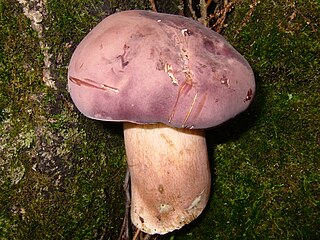
Xanthoconium is a genus of bolete fungi in the family Boletaceae. It was circumscribed by mycologist Rolf Singer in 1944, who included Boletus affinis and what was then known as Gyroporus stramineus as the type species. These two species were part of the "strange group of species described by Murrill and Snell as white-spored Gyropori, and separated by the latter under the new generic name Leucogyroporus." C.B. Wolfe described three species from the United States in 1987: X. chattoogaense, Xanthoconium montaltoense, and X. montanum. As of February 2015, the nomenclatural database Index Fungorum list seven species in Xanthoconium.

Exsudoporus frostii, commonly known as Frost's bolete or the apple bolete, is a bolete fungus first described scientifically in 1874. A member of the family Boletaceae, the mushrooms produced by the fungus have tubes and pores instead of gills on the underside of their caps. Exsudoporus frostii is distributed in the eastern United States from Maine to Georgia, and in the southwest from Arizona extending south to Mexico and Costa Rica. A mycorrhizal species, its fruit bodies are typically found growing near hardwood trees, especially oak.

Tylopilus tabacinus is a species of bolete fungus in the family Boletaceae. It is characterized by a tawny-brown cap measuring up to 17.5 cm (6.9 in) in diameter, and a reticulated stem up to 16.5 cm (6.5 in) long by 6 cm (2.4 in) thick. A characteristic microscopic feature is the distinctive crystalline substance encrusted on the hyphae in the surface of the cap. The species is known from the eastern United States from Florida north to Rhode Island, and west to Mississippi, and from eastern Mexico. It is a mycorrhizal species, and associates with oak and beech trees.
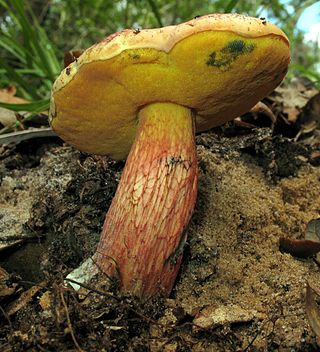
Exsudoporus floridanus is a species of edible bolete mushroom in the family Boletaceae. In 1945, American mycologist Rolf Singer described a species he found in Florida during his 1942–3 tenure of a Guggenheim Memorial Fellowship. He originally described it as a subspecies of the eastern North American species Boletus frostii, but later considered it worthy of distinct species status in a 1947 publication. Based on morphological and phylogenetic data, Vizzini and colleagues transferred this species to a newly described genus Exsudoporus in 2014. Due to lack of sufficient sequences, Wu et al. (2016) were reluctant to accept Exsudoporus and considered it a synonym of Butyriboletus, so they proposed a new combination Butyriboletus floridanus. However, following phylogenetic and morphological analyses clearly resolved Exsudoporus as a monophyletic, homogenous and independent genus that is sister to Butyriboletus.

Boletus curtisii is a species of fungus in the family Boletaceae. It produces small- to medium-sized fruit bodies (mushrooms) with a convex cap up to 9.5 cm (3.7 in) wide atop a slender stem that can reach a length of 12 cm (4.7 in). In young specimens, the cap and stem are bright golden yellow, although the color dulls to brownish when old. Both the stem and cap are slimy or sticky when young. On the underside of the cap are small circular to angular pores. The mushroom is edible, but not appealing. It is found in eastern and southern North America, where it grows in a mycorrhizal association with hardwood and conifer trees. Once classified as a species of Pulveroboletus, the yellow color of B. curtisii is a result of pigments chemically distinct from those responsible for the yellow coloring of Pulveroboletus.
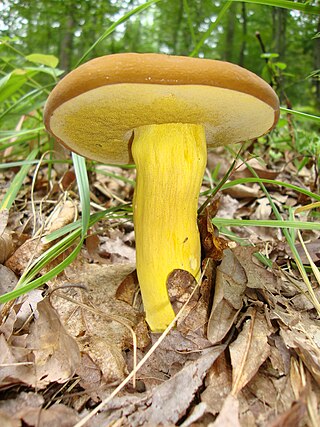
Boletus auripes, commonly known as the butter-foot bolete, is a species of bolete fungus in the family Boletaceae. First described from New York in 1898, the fungus is found in eastern Asia, Central America, and eastern North America from Canada to Florida. It is a mycorrhizal species and typically grows in association with oak and beech trees.
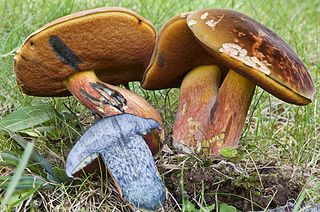
Boletus subvelutipes, commonly known as the red-mouth bolete, is a bolete fungus in the family Boletaceae. It is found in Asia and North America, where it fruits on the ground in a mycorrhizal association with both deciduous and coniferous trees. Its fruit bodies (mushrooms) have a brown to reddish-brown cap, bright yellow cap flesh, and a stem covered by furfuraceous to punctate ornamentation and dark red hairs at the base. Its flesh instantly stains blue when cut, but slowly fades to white. The fruit bodies are poisonous, and produce symptoms of gastrointestinal distress if consumed.

Xerocomellus is a genus of fungi in the family Boletaceae. The genus, as it was described in 2008, contained 12 species. However X. rubellus and X. engelii were transferred to the new genus Hortiboletus and X. armeniacus was transferred to the new genus Rheubarbariboletus in 2015. Molecular analysis supports the distinction of Xerocomellus species from Boletus and Xerocomus, within which these species were formerly contained. Xerocomellus in fact is only distantly related to Xerocomus and is most closely related to Tylopilus, Boletus sensu stricto, Porphyrellus, Strobilomyces, and Xanthoconium.
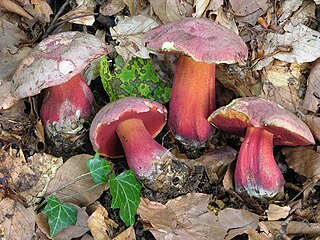
Rubroboletus rubrosanguineus is a species of bolete fungus in the family Boletaceae that is found in Europe.

Imperator torosus, commonly known as the brawny bolete, is a species of bolete fungus in the family Boletaceae. It is native to southern Europe east to the Caucasus and Israel. It is generally associated with deciduous trees such as hornbeam, oak and beech in warm, dry locales. Although generally rare in Europe, it appears to be relatively common in Hungary. Appearing in summer and autumn on chalky soils, the stocky fruit bodies have an ochre cap up to 20 cm (8 in) across, yellow pores on the cap underside, and a wine-red to brown or blackish stipe up to 6–15 cm (2.4–5.9 in) long by 3–6 cm (1.2–2.4 in) wide. The pale yellow flesh changes to different colours when broken or bruised depending on age; younger mushrooms become reddish, and older ones additionally take on bluish tones.

Imperator luteocupreus is a species of bolete fungus in the family Boletaceae. It is native to southern Europe, where it is found under chestnut (Castanea) and oak (Quercus). Although it was originally described in genus Boletus, it was placed in the new genus Imperator in 2015, based on phylogenetic inferences.

Butyriboletus is a genus of fungi in the family Boletaceae. The genus was circumscribed in 2014 by mycologists David Arora and Jonathan L. Frank to accommodate "butter bolete" species that were shown by molecular analysis to be phylogenetically distinct from Boletus. Butyriboletus contains 24 ectomycorrhizal species found in Asia, Europe, North America and north Africa.

Boletus rubriceps is a species of bolete fungus in the family Boletaceae. Although it was officially described as new to science in 2014, the bolete had previously been reported as either Boletus edulis or B. pinophilus. Molecular analysis showed that it was sufficiently different from other morphologically similar Boletus species to warrant designation as a distinct species. It is found in the southwestern United States and southern Rocky Mountains, where it associates with spruce, pine, and sometimes fir. The fruit bodies are edible and highly sought after; they are often sold in farmer's markets of Arizona, New Mexico, and Colorado, and are used in some restaurants. The specific epithet refers to the reddish color of the caps. Common names given to the bolete include "Ruby Porcini", "Rocky Mountain red-capped king bolete” or “Rocky Mountain red".

Baorangia is a fungal genus in the family Boletaceae. It was circumscribed by Chinese mycologists Gang Wu and Zhu L. Yang in 2015 with B. pseudocalopus as the type species. Baorangia emilei and B. bicolor were transferred to the genus from Boletus that same year. The erection of Baorangia follows recent molecular studies that outlined a new phylogenetic framework for the Boletaceae. The generic name—derived from the Chinese words bao ("thin") and rang ("hymenium")—refers to the characteristically thin hymenophore, which distinguishes it from all other Boletaceae genera.
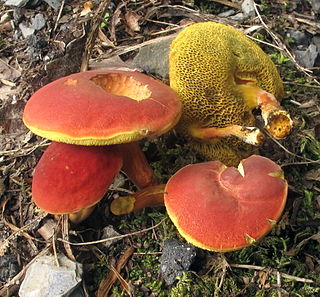
Hortiboletus is a genus of fungi in the family Boletaceae. It was circumscribed in 2015 by Giampaolo Simonini, Alfredo Vizzini, and Matteo Gelardi. The erection of Hortiboletus follows recent molecular studies that outlined a new phylogenetic framework for the Boletaceae. Hortiboletus is derived from the Latin word hortus "garden", referring to a typical habitat of the type species, Hortiboletus rubellus. The bolete H. bubalinus, originally described as a Boletus and later placed in Xerocomus, was transferred to the genus by Bálint Dima. In 2015, Alona Yu. Biketova transferred Boletus campestris and Boletus engelii to Hortiboletus.
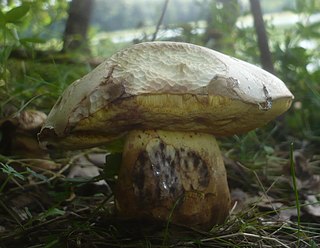
Caloboletus kluzakii is a bolete fungus native to Europe. Until 2014, it was known as Boletus kluzakii. Recent changes in the phylogenetic framework of the family Boletaceae prompted the transfer of this species, along with several other related boletes, including Caloboletus calopus, to the genus Caloboletus. It was described scientifically in 2006 by Josef Šutara and Pavel Špinar, from specimens collected in the Czech Republic. The fungus had earlier been published with the name Boletus fallax by Czech mycologist Zdeněk Kluzák in 1988, but this was invalid, as that name had been used previously by E.J.H. Corner for a Malaysian bolete. The epithet honours Kluzák's contributions in describing the species.



















